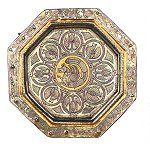Serving the Guest: A Sufi Cookbook
Essays | Recipes | Gallery

A merchant of Konya, a student of Mevlana Jalaluddin Rumi, went on the pilgrimage to Mecca. On the evening of Id al-Adha, the Feast of the Sacrifice, his wife prepared sweets to share with her family and the poor, as she awaited the safe return of her husband.
She sent a tray full of the sweets to Mevlana, asking that when he ate, he might remember her husband in his prayers. Mevlana invited some of his other students to share the sweets with him. They helped themselves to as much as they could, but there was no end to the sweets. Mevlana then carried the tray upstairs to the roof of the tekke and called out — it seemed to no one at all — "Here! Take your share!" He returned to his students empty-handed.
The merchant returned from the hajj and paid his respects to his teacher, who was glad to see that his student had arrived safely. Later, when the pilgrim's servants were unpacking his belongings, his wife saw the tray amongst them. She asked her husband how it got into his baggage. The merchant said that during the pilgrimage, while he and his companions were camped on the plain of Arafat, he saw a tray of sweets handed through the curtain of his tent. No one could find the owner of the hand that bore the tray, though they looked all around.
The husband and wife went to Mevlana and told him the story. He answered that the miracle was a sign of their trust and faith, and that only Allah, the Compassionate and Merciful, could have enabled it to occur.
from Serving the Guest: A Sufi Cookbook
Copyright © 1999, 2000 by Kathleen Seidel
Sources of previously published material by other authors used by permission, and print sources for images, may be found at http://www.superluminal.com/cookbook.